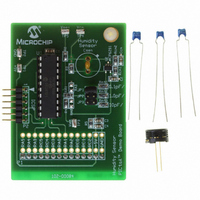PIC16F690DM-PCTLHS Microchip Technology, PIC16F690DM-PCTLHS Datasheet - Page 183

PIC16F690DM-PCTLHS
Manufacturer Part Number
PIC16F690DM-PCTLHS
Description
BOARD DEMO PICTAIL HUMIDITY SNSR
Manufacturer
Microchip Technology
Series
PICtail™r
Datasheets
1.PIC16F690DM-PCTLHS.pdf
(36 pages)
2.PIC16F690DM-PCTLHS.pdf
(32 pages)
3.PIC16F690DM-PCTLHS.pdf
(306 pages)
4.PIC16F690DM-PCTLHS.pdf
(14 pages)
Specifications of PIC16F690DM-PCTLHS
Sensor Type
Humidity
Sensing Range
1 ~ 99% RH
Interface
Analog
Voltage - Supply
5V
Embedded
Yes, MCU, 8-Bit
Utilized Ic / Part
MCP6291, PIC16F690
Processor To Be Evaluated
MCP6291 and PIC16F690
Interface Type
ICSP
Lead Free Status / RoHS Status
Lead free / RoHS Compliant
For Use With
AC162061 - HEADER INTRFC MPLAB ICD2 20PIN
Sensitivity
-
Lead Free Status / RoHS Status
Lead free / RoHS Compliant, Lead free / RoHS Compliant
- PIC16F690DM-PCTLHS PDF datasheet
- PIC16F690DM-PCTLHS PDF datasheet #2
- PIC16F690DM-PCTLHS PDF datasheet #3
- PIC16F690DM-PCTLHS PDF datasheet #4
- Current page: 183 of 306
- Download datasheet (6Mb)
REGISTER 13-2:
© 2008 Microchip Technology Inc.
bit 7
Legend:
R = Readable bit
-n = Value at POR
bit 7
bit 6
bit 5
bit 4
bit 3-0
Note 1: PIC16F687/PIC16F689/PIC16F690 only.
WCOL
R/W-0
2: When this mode is selected, any reads or writes to the SSPADD SFR address actually accesses the SSPMSK register.
WCOL: Write Collision Detect bit
1 = The SSPBUF register is written while it is still transmitting the previous word (must be cleared in software)
0 = No collision
SSPOV: Receive Overflow Indicator bit
In SPI mode:
1 = A new byte is received while the SSPBUF register is still holding the previous data. In case of overflow, the
0 = No overflow
In I
1 = A byte is received while the SSPBUF register is still holding the previous byte. SSPOV is a “don’t care” in
0 = No overflow
SSPEN: Synchronous Serial Port Enable bit
In SPI mode:
1 = Enables serial port and configures SCK, SDO and SDI as serial port pins
0 = Disables serial port and configures these pins as I/O port pins
In I
1 = Enables the serial port and configures the SDA and SCL pins as serial port pins
0 = Disables serial port and configures these pins as I/O port pins
In both modes, when enabled, these pins must be properly configured as input or output.
CKP: Clock Polarity Select bit
In SPI mode:
1 = Idle state for clock is a high level (Microwire default)
0 = Idle state for clock is a low level (Microwire alternate)
In I
SCK release control
1 = Enable clock
0 = Holds clock low (clock stretch). (Used to ensure data setup time.)
SSPM<3:0>: Synchronous Serial Port Mode Select bits
0000 = SPI Master mode, clock = F
0001 = SPI Master mode, clock = F
0010 = SPI Master mode, clock = F
0011 = SPI Master mode, clock = TMR2 output/2
0100 = SPI Slave mode, clock = SCK pin. SS pin control enabled.
0101 = SPI Slave mode, clock = SCK pin. SS pin control disabled. SS can be used as I/O pin.
0110 = I
0111 = I
1000 = Reserved
1001 = Load SSPMSK register at SSPADD SFR address
1010 = Reserved
1011 = I
1100 = Reserved
1101 = Reserved
1110 = I
1111 = I
2
2
2
SSPOV
R/W-0
C™ mode:
C mode:
C mode:
data in SSPSR is lost. Overflow can only occur in Slave mode. The user must read the SSPBUF, even if only
transmitting data, to avoid setting overflow. In Master mode, the overflow bit is not set since each new recep-
tion (and transmission) is initiated by writing to the SSPBUF register.
Transmit mode. SSPOV must be cleared in software in either mode.
SSPCON: SYNC SERIAL PORT CONTROL REGISTER
2
2
2
2
2
C Slave mode, 7-bit address
C Slave mode, 10-bit address
C Firmware Controlled Master mode (slave IDLE)
C Slave mode, 7-bit address with Start and Stop bit interrupts enabled
C Slave mode, 10-bit address with Start and Stop bit interrupts enabled
W = Writable bit
‘1’ = Bit is set
SSPEN
R/W-0
PIC16F631/677/685/687/689/690
OSC
OSC
OSC
R/W-0
CKP
/4
/16
/64
U = Unimplemented bit, read as ‘0’
‘0’ = Bit is cleared
SSPM3
R/W-0
(2)
(2)
SSPM2
R/W-0
(2)
(1)
x = Bit is unknown
SSPM1
R/W-0
(2)
DS41262E-page 181
SSPM0
R/W-0
(2)
bit 0
Related parts for PIC16F690DM-PCTLHS
Image
Part Number
Description
Manufacturer
Datasheet
Request
R

Part Number:
Description:
Manufacturer:
Microchip Technology Inc.
Datasheet:

Part Number:
Description:
Manufacturer:
Microchip Technology Inc.
Datasheet:

Part Number:
Description:
Manufacturer:
Microchip Technology Inc.
Datasheet:

Part Number:
Description:
Manufacturer:
Microchip Technology Inc.
Datasheet:

Part Number:
Description:
Manufacturer:
Microchip Technology Inc.
Datasheet:

Part Number:
Description:
Manufacturer:
Microchip Technology Inc.
Datasheet:

Part Number:
Description:
Manufacturer:
Microchip Technology Inc.
Datasheet:

Part Number:
Description:
Manufacturer:
Microchip Technology Inc.
Datasheet:










